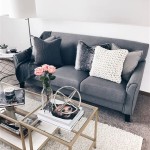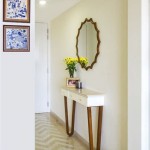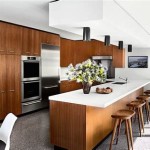Ideas How to Decorate a Big Living Room
Decorating a large living room presents a unique set of challenges and opportunities. The expansive space, while offering creative freedom, can easily feel impersonal, empty, or poorly balanced if not approached with a deliberate design strategy. The key is to break down the area into distinct zones, establish a cohesive aesthetic, and incorporate elements that foster both comfort and visual appeal.
Successfully decorating a large living room hinges on a multi-faceted approach that considers the architectural features of the room, the desired functionality, and the overall style preference. This article will explore several key concepts and ideas to guide the decoration process, transforming a potentially overwhelming space into a welcoming and stylish haven.
Define Distinct Zones Within the Space
One of the most crucial aspects of decorating a large living room is defining separate zones. A vast, undifferentiated space can feel cavernous and unwelcoming. By creating distinct areas for different activities, the room becomes more functional and visually engaging. Consider the various activities that will take place in the living room, such as watching television, reading, socializing, or playing games. Each activity can be designated a specific area within the room.
For example, a conversation area can be created around a coffee table with a sofa and armchairs. This zone can be anchored by a large area rug, further defining the space. A separate reading nook can be established with a comfortable armchair, a floor lamp, and a small side table. If the room has enough space, a game area with a table and chairs can be set up. The key is to ensure that each zone has a clear purpose and is visually distinct from the others.
The transition between zones should be seamless and visually appealing. Use furniture placement, area rugs, and changes in flooring to create subtle divisions. For instance, a console table can act as a divider between a seating area and a walkway. Changes in wall color or texture can also delineate different zones. The goal is to create a sense of flow and cohesion while maintaining the individuality of each area.
Consider also the existing architectural features of the room when defining zones. A fireplace can serve as a natural focal point for a seating area. A large window can be the ideal spot for a reading nook, providing ample natural light. Use these features to your advantage when planning the layout of the room.
Ultimately, defining distinct zones in a large living room is about creating a sense of order and purpose. It transforms a potentially overwhelming space into a series of smaller, more manageable areas, each designed for a specific activity. This approach not only enhances the functionality of the room but also adds visual interest and character.
Scale and Proportion in Furniture Selection
Selecting furniture that is appropriately scaled for a large living room is paramount. Using furniture that is too small will make the space feel empty and disproportionate. Conversely, oversized furniture can overwhelm the room and make it feel cramped. The key is to find pieces that are proportionate to the size of the room and to each other.
Consider the overall dimensions of the room when choosing furniture. A large sofa, sectional, or multiple seating arrangements are generally necessary to fill the space effectively. Avoid small, delicate pieces that will get lost in the vastness of the room. Instead, opt for furniture with substantial presence and visual weight. This could include oversized armchairs, large coffee tables, and substantial side tables.
The height of the furniture is also an important consideration. Tall bookcases, large artwork, and high-backed chairs can help to fill the vertical space and prevent the room from feeling too horizontal. However, be mindful of obstructing sightlines and maintaining a sense of balance. The goal is to create a visually dynamic space without overwhelming the senses.
Pay attention to the spacing between furniture pieces. Allow for ample walkways to ensure that the room remains functional and easy to navigate. A good rule of thumb is to leave at least three feet of space between furniture pieces and walls. This will prevent the room from feeling cluttered and allow for comfortable movement.
Rugs play a crucial role in defining seating areas and adding warmth to a large living room. Choose a rug that is large enough to anchor the entire seating arrangement. Ideally, the front legs of all the furniture pieces should sit on the rug. This will create a cohesive and inviting space.
In addition to furniture, consider the scale of accessories. Large lamps, oversized artwork, and substantial decorative objects can help to fill the space and add visual interest. Avoid small, scattered accessories that will get lost in the room. Instead, group accessories together to create focal points and add a sense of order.
Therefore, selecting furniture and accessories of appropriate scale is essential for creating a balanced and visually appealing large living room. Avoid pieces that are too small or too large, and pay attention to the spacing and arrangement of furniture to ensure that the room remains functional and comfortable.
Light and Color: Defining the Atmosphere
Light and color are powerful tools that can significantly impact the atmosphere of a large living room. A well-lit and thoughtfully colored room can feel warm, inviting, and visually stimulating. Conversely, a poorly lit or poorly colored room can feel cold, impersonal, and uninviting. Therefore, careful consideration should be given to both light and color when decorating a large living room.
Natural light is always the most desirable source of illumination. Maximize the amount of natural light entering the room by keeping windows uncovered or using sheer curtains. If natural light is limited, supplement with artificial lighting. A combination of ambient, task, and accent lighting is ideal for creating a well-lit and functional space.
Ambient lighting provides overall illumination for the room. This can be achieved with recessed lighting, chandeliers, or large lamps. Task lighting provides focused light for specific activities, such as reading or working. This can be achieved with floor lamps, table lamps, or pendant lights. Accent lighting highlights architectural features or artwork. This can be achieved with spotlights, track lighting, or picture lights.
When selecting light fixtures, consider the style and scale of the room. Large chandeliers or statement lamps can add drama and visual interest to a vast space. However, ensure that the fixtures are proportionate to the size of the room and that they do not obstruct sightlines.
Color plays a crucial role in shaping the atmosphere of a living room. Light and airy colors can make a space feel larger and more open. Dark and saturated colors can create a more intimate and cozy atmosphere. Consider the overall style and mood that you want to create when selecting colors for the walls, furniture, and accessories.
Neutral colors, such as white, beige, and gray, are often a good choice for large living rooms. These colors provide a versatile backdrop for furniture and accessories and can be easily updated over time. However, avoid using too much neutral color, as this can make the room feel bland and uninteresting. Add pops of color with artwork, pillows, rugs, and other accessories.
When selecting colors for a large living room, consider the color palette of the adjacent rooms. The goal is to create a cohesive and harmonious flow throughout the home. Use similar colors or complementary colors to tie the spaces together. However, feel free to experiment with different shades and tones to create visual interest.
In conclusion, using light and color effectively is essential for creating a warm, inviting, and visually appealing large living room. Maximize natural light, supplement with artificial lighting, and choose colors that reflect your personal style and complement the overall aesthetic of the home.
Adding Texture and Visual Interest
In a large living room, texture becomes an essential tool for creating visual interest and preventing the space from feeling flat or monotonous. Texture refers to the surface quality of materials, both tactile and visual. Incorporating a variety of textures throughout the room adds depth, dimension, and a sense of richness.
Start by considering the textures present in the existing architectural elements. Exposed brick, wood beams, or textured walls can serve as starting points for building a textured palette. If these elements are not present, consider adding them through architectural details such as wainscoting, crown molding, or textured wallpaper.
Furniture is a prime opportunity to introduce texture. Upholstered pieces in a variety of fabrics can add visual and tactile interest. Consider a combination of materials such as velvet, linen, leather, and wool. Each fabric has a unique texture that can contribute to the overall aesthetic of the room. Mixing different textures within a single seating area can create a more layered and dynamic look.
Area rugs are another excellent way to add texture to a large living room. Choose rugs with interesting patterns, weaves, or piles. A shag rug can add a cozy and inviting feel, while a jute rug can add a more rustic and natural touch. Consider layering rugs of different textures and patterns to create a more complex and visually appealing floor covering.
Accessories provide endless opportunities for incorporating texture. Throw pillows in a variety of fabrics, patterns, and sizes can add a comfortable and inviting touch to sofas and armchairs. Blankets and throws in various materials can be draped over furniture or stored in baskets, adding both visual interest and practical comfort. Decorative objects made of different materials, such as ceramics, wood, metal, and glass, can be displayed on shelves, tables, or mantels, adding layers of texture and visual appeal.
Plants are a natural and organic way to add texture to a large living room. The varying shapes, sizes, and textures of foliage can bring life and vitality to the space. Consider incorporating a mix of different plants, from small succulents to large floor plants, to create a diverse and textured botanical display.
Window treatments can also contribute to the overall texture of the room. Curtains in a variety of fabrics, such as linen, velvet, or silk, can add both visual and tactile interest. Blinds and shades in different materials, such as wood, bamboo, or fabric, can also add texture and dimension to the windows.
Introducing texture is not just about adding different materials; it's also about creating contrast. Juxtapose smooth surfaces with rough surfaces, soft textures with hard textures, and natural materials with synthetic materials. This creates a more dynamic and engaging visual experience.
Therefore, adding texture and visual interest is essential for creating a large living room that is both visually appealing and comfortably inviting. By incorporating a variety of textures through furniture, rugs, accessories, and architectural details, you can transform a potentially bland space into a rich and dynamic environment.

13 Tricks To Decorating A Large Living Room

13 Strategies For Making A Large Room Feel Comfortable

10 Tips For Styling Large Living Rooms Other Awkward Spaces The Inspired Room

Stylish Ideas For A Large Living Room Love Happens Mag

Design Big 23 Large Living Room Decor Ideas Rugs Direct

Interior Design Ideas Large Living Room

Interior Design Ideas For Large Living Rooms Flooring

Three Simple Wall Of Art Ideas Farm House Living Room Small Decor Interior Design

77 Best Living Room Decor Ideas 2025 Unique

Luxury Interior Design Ideas Living Room For A Big Family







